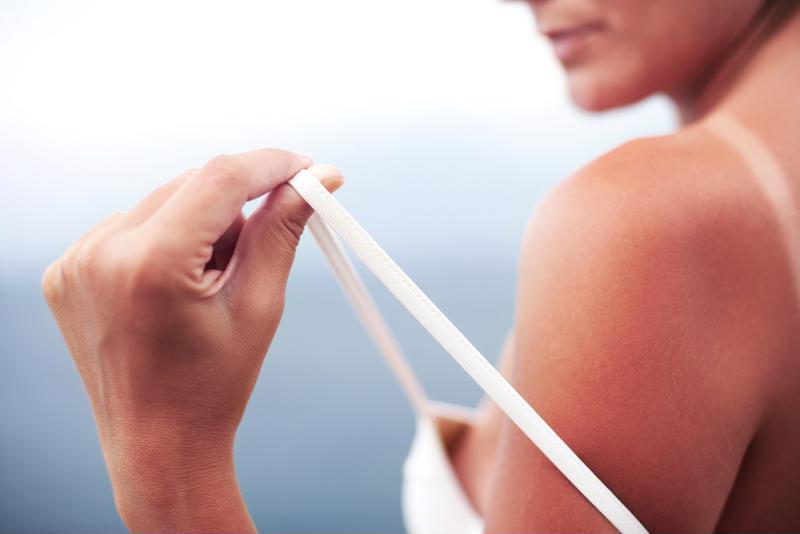For many, summertime means spending as much time outdoors as possible. Whether you’re on the beach or hanging out in your own backyard, there are plenty of opportunities to soak up the sun. Too much UV ray exposure can cause minor to severe side effects if you’re not properly protected, however. This includes wrinkles, age spots, sunburn and potential skin cancer, according to dermatologist Robert Friedman.
“Sunburn may seem like just a temporary situation,” Friedman told The Huffington Post. “It looks bad, it hurts, it peels, but it can also cause long-lasting damage to the skin, such as wrinkles or even skin cancer.
While age spots occur over time, sunburn is an issue that can make navigating normal everyday tasks more uncomfortable than usual. Blistering sunburns can even lead to melanoma later in life, according to the Cleveland Clinic. Using protective lotion and clothing is your best bet against sunburn, but it can still occur by chance.
If you’re currently dealing with sunburn or want to prepare for the future, consider these tips for treating the burn and discomfort:
1. Apply a cold compress to the skin
The American Academy of Dermatology recommended placing a cold, damp towel to the skin for about 15 minutes multiple times a day. This is a simple way to reduce inflammation and cool down your skin when the heat becomes unbearable.
“Place a cold, damp towel to the skin for about 15 minutes multiple times a day.”
If you can handle the chill, you can also submerge your skin in a cold bath or shower. When you’re finished, don’t dry yourself completely; dab yourself with a towel to leave excess water on the skin to continue cooling and hydrating.
2. Use a rich, moisturizing lotion
After taking a cold bath, make sure to moisturize the skin to stay hydrated. Aloe can be used as an anti-inflammatory topical, and ingredients like soy and oatmeal are great for calming irritated skin, according to dermatologist Whitney Bowe.
“When choosing a lotion, reach for something that is both moisturizing and hydrating so that it helps trap moisture in the skin,” Bowe told the Huffington Post. “Look for ingredients like ceramides, glycerin or soy. I also like lotions that contain oatmeal, which is particularly soothing. Some fancier creams contain antioxidants like vitamins C and E, which can also help tame inflammation in the skin. But avoid creams with petroleum, because those will trap heat in your skin.”
Hydrocortisone cream can also be used for relief.
3. Hydrate
Sunburn doesn’t only dry out the skin – it also dehydrates your body as a whole. The Skin Cancer Foundation suggested drinking plenty of liquids when you’re sunburnt, such as water and sports drinks that are loaded with electrolytes. Continue hydrated after your skin heals, and in general when you’re spending lots of time in the sun.
4. Reduce inflammation
Extreme inflammation can be difficult to reduce with a cold compress or aloe vera. Another helpful option to consider is a nonsteroidal anti-inflammatory drug, such as ibuprofen or aspirin. Both of these medications can help reduce both discomfort, inflammation and redness.
 Avoid the sun as soon as you notice the burn.
Avoid the sun as soon as you notice the burn.5. Give blisters a chance to heal
Just like dermatologists recommend neglecting the sensation to pop your pimples, the same goes for blisters. If blisters appear in your skin after spending too much time in the sun, this means you have a second-degree burn. Blisters are the natural bandage that forms over your skin to help it heal and reduce your risk of experiencing an infection. If you’re concerned about your blisters or they become difficult to cope with, see a specialist for care or additional support.
6. Protect your skin for the future
Make it a priority to apply sunscreen that has an SPF of 30 or higher and is also water resistant. You can also wear protective clothing and stay inside during the peak sunshine hours, or at the very least take breaks from the direct sunlight continuously through the day. Getting an opinion from a dermatologist or specialist with a full body check is another way to be proactive and reduce your risk for skin care. Maryland Plastic Surgery and Pure MedSpa provides this service to assess any moles of various colors and sizes, raised bumps, painful sores, lesions or other concerns you may have with your skin.
We recommend annual skin screenings to check for skin cancer, as most early diagnoses are almost always curable. Take care of your body and schedule your consultation with Maryland Plastic Surgery today.



